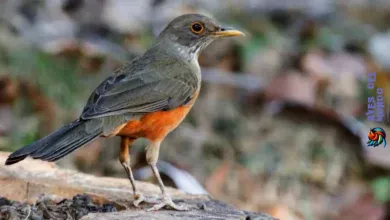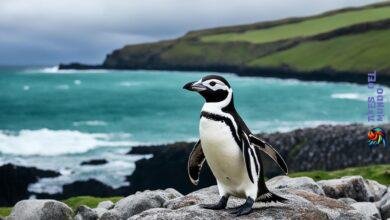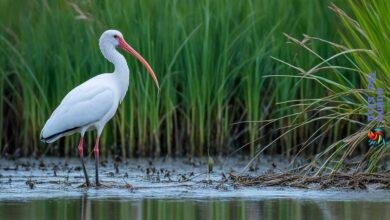Imagine falling into the small group, 20% of bird species, that take on huge migratory journeys. These birds cover continents and oceans, driven by instincts. They travel thousands of kilometers, from north to south, navigating by the earth’s magnetic fields, stars, and sun.
Every year, birds take off on a migration that tests their strength and will. You see bird migration at a scale that’s amazing, with some flying further than any human has explored. Why do they go on these risky trips? They’re after better breeding spots, food, and following their ancient instincts toward where they need to be.
Looking into how and why birds fly across the world is more than science. It’s a look into a survival story, how they adapt, and their bond with the earth. These migratory birds share epic stories of their journeys. Perhaps, in their flight, you’ll see parallels to your own life’s paths.
Understanding Bird Migration Patterns
Bird migration is driven by a strong survival instinct. This moves many species around the world to find resources. Bird migration is crucial for the survival of various bird species. It helps keep their populations going. It’s important to know why birds migrate, how far they go, and their migration schedules. This info lets us understand how migratory birds live their lives.
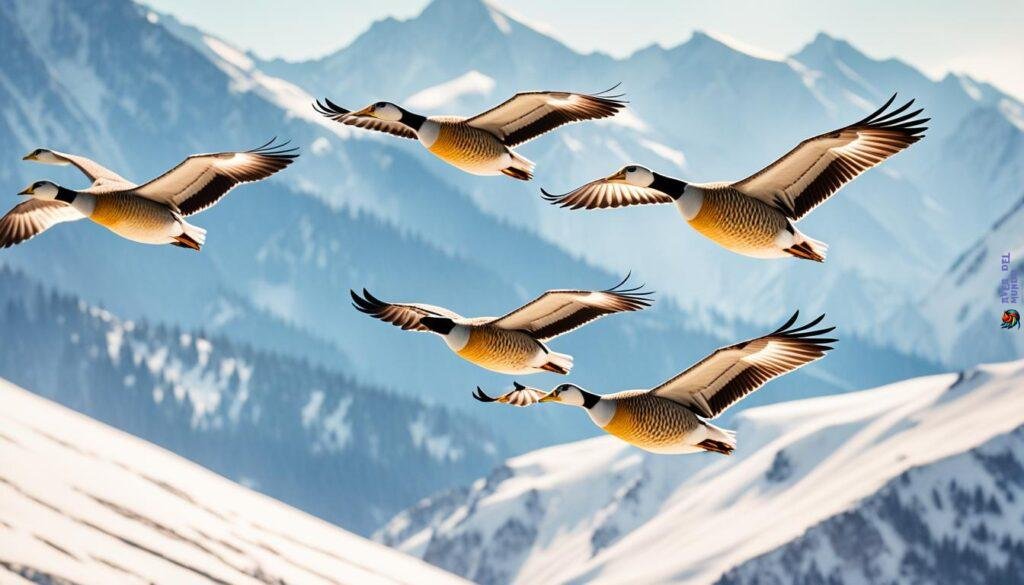
The Rhythms of Nature: Why Birds Migrate
Season changes lead birds to move. They look for food and better weather. These movements match nature’s rhythms. Knowing this, we see how key it is to protect birds. Saving their homes supports their migration cycles. This is vital for their survival.
Varied Distances: Short to Long-Distance Migratory Birds
Studying migratory birds shows us their different journey lengths. Some move up and down mountains for comfort. Others travel thousands of miles across continents. These journeys show how tough and adaptable birds are. It proves saving them is critical.
Seasonal Movements: Tracking Timelines
Bird migrations are well-planned. They happen at certain times for specific reasons. This shows how birds interact with their environments. Watching these migrations tells us about changes in nature. It also shows how we might be affecting them. Helping in bird conservation comes from understanding this. It’s about preserving the delicate balance birds rely on.
Notable Avian Marathoners: Species That Go the Distance
For those who love bird watching, seeing migratory birds is thrilling. Some birds go incredibly long distances, showing their amazing stamina. Take the Bar-headed Goose, it travels between 3,000 to 5,000 km. It flies over the high Himalayas where the air is very thin and cold.
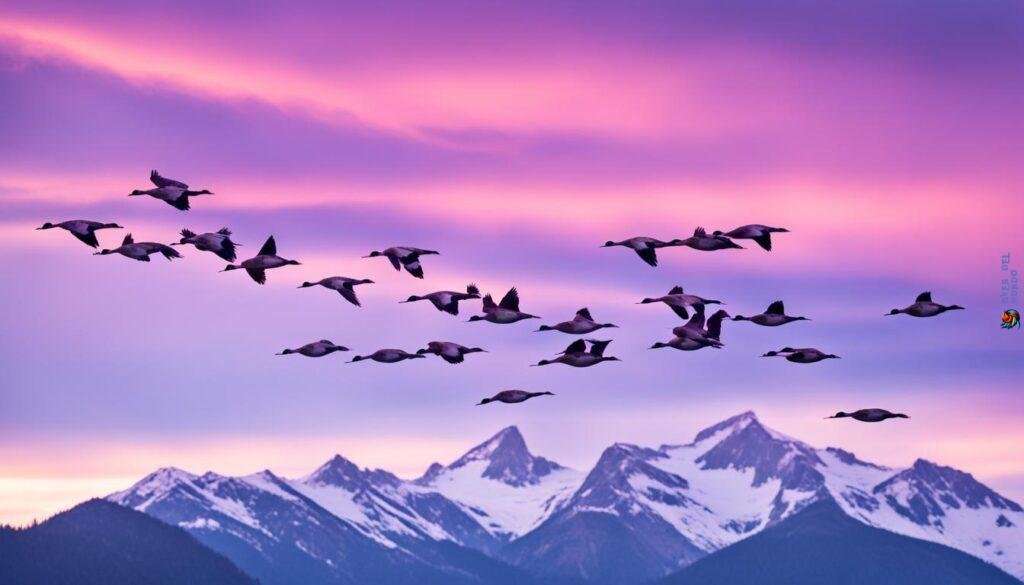
Even with challenges like losing their homes, these birds manage their energy well during their trips. The Great Snipe, though quite hefty, can fly super fast. It goes up to 97 km/h, covering a massive 6,800 km from Scandinavia to sub-Saharan Africa without stopping.
Here’s a quick look at how strong and far these birds can travel:
| Species | Migration Distance | Remarkable Traits |
|---|---|---|
| Bar-headed Goose | 3,000-5,000 km | High-Altitude Flight over 7,000 meters |
| Great Snipe | 6,800 km | High-Speed Flight at 97 km/h without breaks |
Learning about these migrations teaches us a lot and adds excitement to bird watching. Watching these birds move with the seasons shows us the wonders of nature. It’s not just beautiful; it makes us think about how incredible nature is.
Exploring the life of migratory birds
The yearly journey of migratory birds is nature’s marvel. It shows how they survive and adapt. Watching these birds teaches us about their lives and the need to save them. This highlights why we must protect places where they live.

The Perks and Perils of Long-Distance Journeys
Migratory birds travel far for food and to have their young. Yet, they face many dangers. Bad weather, predators, and losing their homes are big problems. These threats make safe travel essential for their survival.
Adaptations Facilitating Epic Treks
Birds have special abilities that help them fly long distances. For example, the Bar-tailed Godwit flies from Alaska to New Zealand. This journey is over 11,000 km. Keeping their travel paths safe is vital for these birds.
| Species | Distance Travelled | Adaptations | Challenges Faced |
|---|---|---|---|
| Bar-tailed Godwit | 11,000+ km | Ability to store energy as fat, advanced navigational skills | Habitat loss, climate change |
| Red Knot | 9,000+ km | Efficient foraging behavior, synchronized migration | Overharvesting of horseshoe crab eggs, coastal development |
Migratory birds face many challenges, including those from humans. Saving their habitats and helping them are crucial. Without these efforts, we might lose the beauty of their journeys.
The Phenomenal Flight of the Arctic Tern
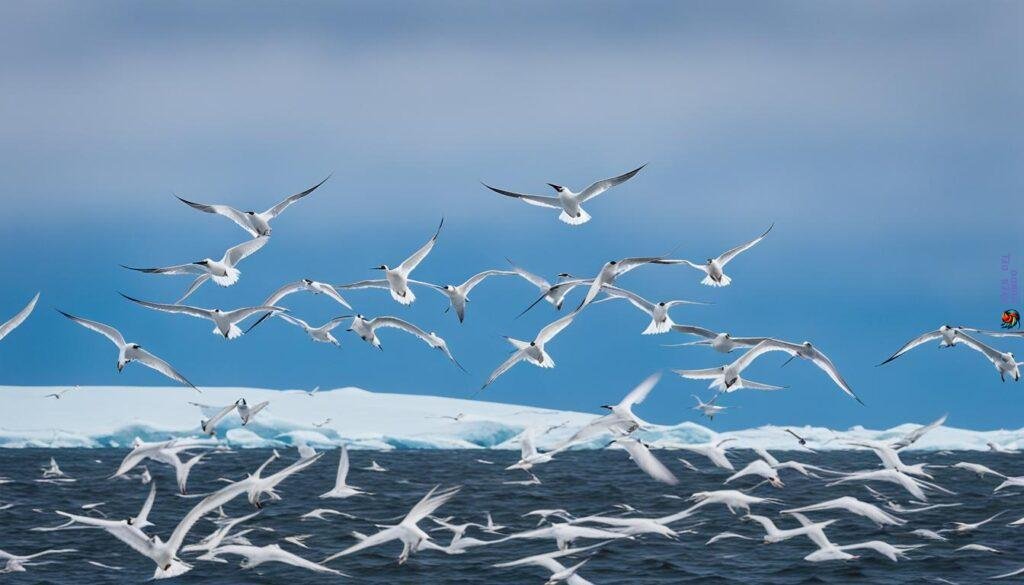
The Arctic Tern’s journey is a remarkable event in nature. For those who love bird watching or are fascinated by bird migration patterns, this bird is especially interesting. Each year, they travel an amazing 90,000 km from one pole to the other.
A Lifetime of Migration: Accumulated Distances
Over their 30-year lifetime, Arctic Terns travel distances that will leave you in awe. If you enjoy bird watching, the sheer distance they cover is astounding. They fly a distance greater than to the moon and back, showing their incredible journeying spirit.
From Pole to Pole: Navigating Extreme Distances
The Arctic Tern’s trips between the poles occur twice a year. This allows them to enjoy more sunlight yearly than any other creature. Their migration is a peak example of bird migration patterns, with a path that maximizes access to key resources. Watching their migration is like seeing a global odyssey, each wingbeat showing the strength of life.
The Bar-tailed Godwit’s Non-stop Pacific Crossing
For fans of bird watching, the Bar-tailed Godwit is a true marvel. This bird species stuns everyone with its incredible journey during bird species migration. It flies nearly 12,200 kilometers straight from Alaska to New Zealand without stopping. This feat showcases their amazing endurance and strength across long bird migration routes.
Every year, these fearless travelers tackle a journey that seems almost impossible, spanning the entire Pacific Ocean without pausing to rest or eat. It’s a remarkable display of stamina in the world of birds.
Let’s look closely at the Bar-tailed Godwit’s trip:
| Characteristic | Detail |
|---|---|
| Flight Duration | Approximately 8-9 days |
| Distance Covered | Approximately 12,200 km (7,580 miles) |
| Departure Point | Alaska, USA |
| Arrival Point | New Zealand |
| Major Challenges | Weather conditions, Orientation, Energy Conservation |
These fascinating migration routes draw our interest and admiration. During migration times, bird watching becomes even more exciting. We eagerly watch the skies to spot these flying wonders. The Bar-tailed Godwit shows us what extreme migration is all about. It highlights the astonishing journeys that occur in nature.
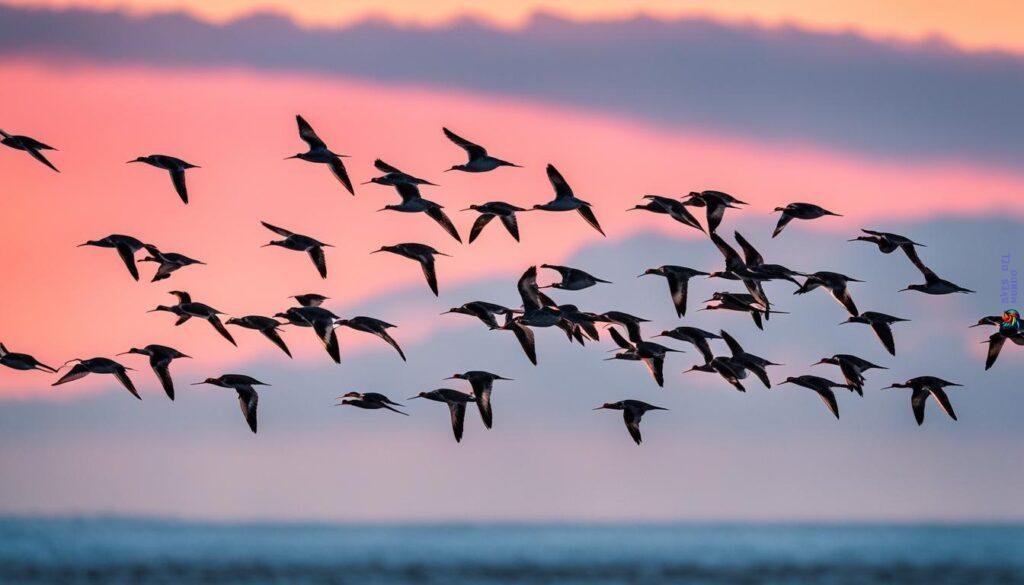
Strategic Rest Stops: How Migratory Birds Refuel
Migratory birds go on amazing trips across lands and seas. They rely on certain spots to rest and eat, gaining the energy they need. These spots are critical for their survival, highlighting why bird conservation efforts are key.
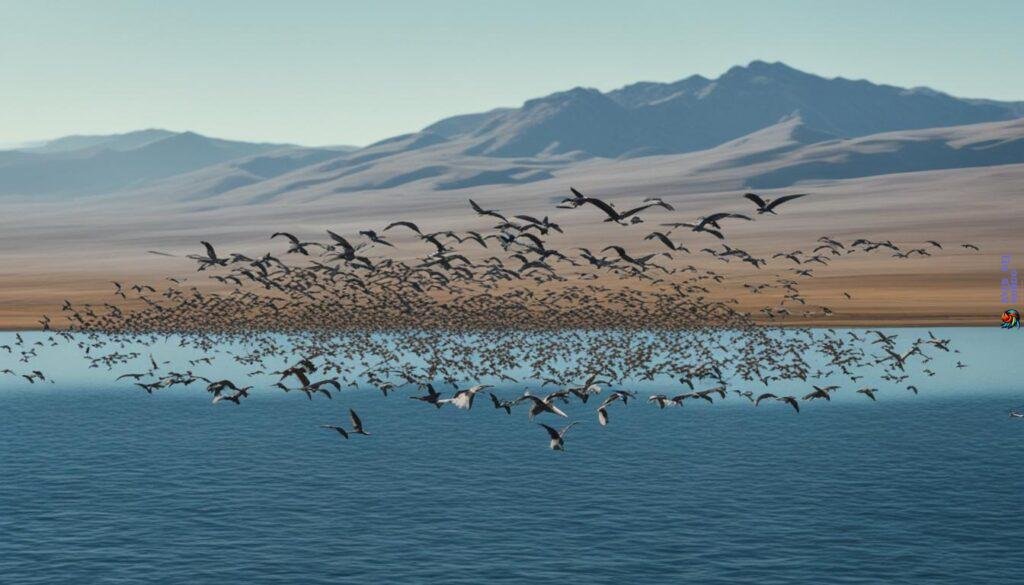
Importance of Stopover Sites and Conservation
Traveling is hard on birds, making rest stops essential. Conservationists work hard to keep these areas safe. This helps birds feed and rest, letting them reach their seasonal homes.
Human Impact on Migratory Routes
Our actions have changed the natural world, affecting bird travels. Building, farming, and climate shifts threaten their habitats. Without these rest areas, entire bird groups could be at risk.
| Region | Threats to Stopover Sites | Conservation Actions |
|---|---|---|
| Western Hemisphere | Urban development, farming | Protected area establishment |
| Yellow Sea | Reclamation projects, pollution | International cooperation, Ramsar site designation |
| Central Asian Flyway | Overgrazing, desertification | Grassland management, sustainable practices |
| Mississippi Flyway | Pesticide use, logging | Habitat restoration, policy reform |
Successful bird conservation efforts aim to fix the problems we cause. By supporting these actions, we can save important habitats. This ensures birds can safely migrate every year.
Migratory Bird Habitats: Breeding and Wintering Grounds
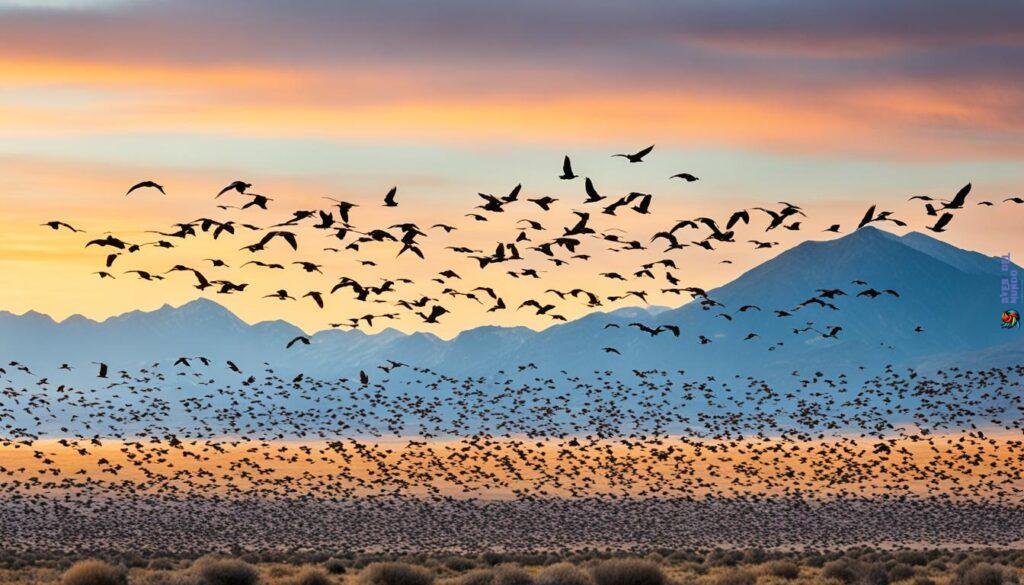
The importance of migratory bird habitats is big for bird migration. These habitats must have the right conditions for their life cycle. The space between breeding and wintering grounds can be very far, sometimes thousands of kilometers.
The Adélie Penguin has a journey of about 13,000 km each year to breed. Then, the Short-tailed Shearwater travels even further, over 30,000 km. Both breeding and wintering grounds are vital. They provide shelter and food, which are key for survival.
By protecting these essential habitats, we keep the sky full of migrating birds. This supports our planet’s ecological balance.
Here’s a table showing migratory birds and how far they travel between habitats:
| Species | Breeding Ground Location | Wintering Ground Location | Approximate Distance (km) |
|---|---|---|---|
| Adélie Penguin | Antarctica | Coastal Antarctica and Sub-Antarctic Islands | 13,000 |
| Short-tailed Shearwater | Tasmania, Australia | Northern Pacific Ocean | 30,000 |
| Arctic Tern | Arctic and Subarctic Regions | Antarctic Coast | 90,000 |
| Bar-tailed Godwit | Alaska, USA | New Zealand and Eastern Australia | 11,000 – 12,200 |
Helping to save migratory bird habitats is very important. It keeps the wonder of bird migration alive for future generations. By keeping these places safe, we also support ongoing research and enjoyment of our natural world.
Migratory Birds and Conservation Efforts
Bird conservation is vital for keeping our ecosystem healthy and balanced. Through studying migratory birds, we understand their complex behaviors. We also see why we must protect them during their long trips across the sky.
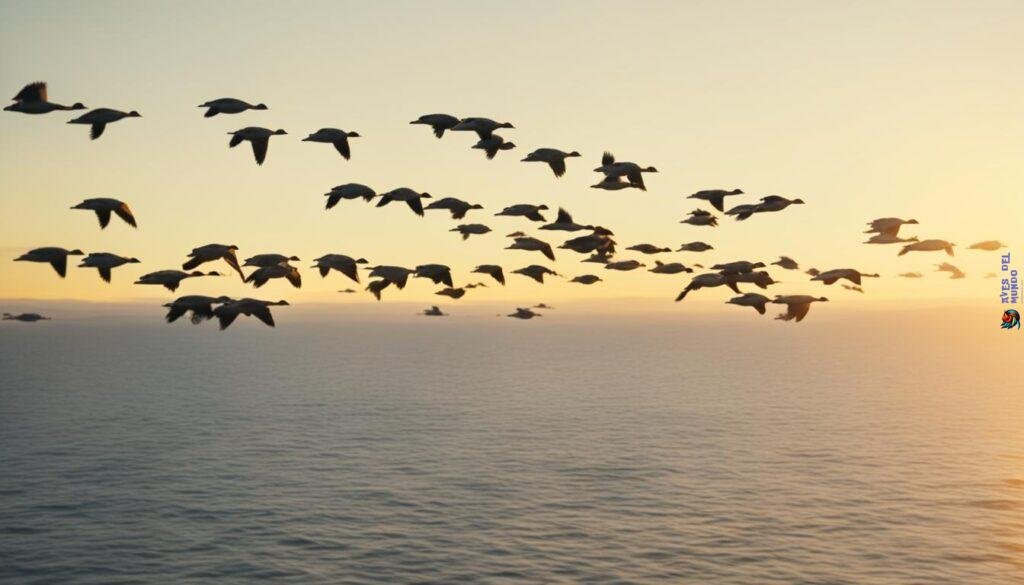
Bird Conservation Legislation: MBTA and Beyond
Our feathery companions gain safety through laws like the Migratory Bird Treaty Act (MBTA). This law is a key part of bird conservation. It protects many species from the side effects of industrial expansion and human activity. Recent political measures have reinforced these protections, showing a renewed promise to a future where birds thrive.
Advocacy Programs and Their Impact on Avian Routes
We all play a role in safeguarding migratory birds. Advocacy programs teach communities, encourage bird-friendly habits, and fight the negative impacts of habitat loss on birds. By supporting these efforts, we’re not just learning about birds. We’re helping to ensure they survive and flourish.
| Conservation Program | Target Species | Conservation Focus |
|---|---|---|
| Coastal Bird Preservation | Red Knots, Piping Plovers | Protection of breeding and nesting areas on coastlines. |
| Wetlands Restoration Initiative | Wood Storks, Sandhill Cranes | Rehabilitation of freshwater marshes and estuaries as stopover sites. |
| Urban Flight Safety Education | Songbirds, Raptors | Reducing urban light pollution and preventing bird-window collisions. |
| International Migratory Bird Day | All Migratory Species | Annual event for raising awareness and promoting global bird conservation efforts. |
By backing projects like these, you help keep our skies filled with the beauty of bird migration. This ensures that bird populations will continue to thrive for future generations to see and enjoy.
The Great Snipe’s Impressive Energy Reserves
The Great Snipe is known for its amazing flights during bird species migration. In the world of bird watching, it’s famous for flying over continents without stopping. Studying the migratory bird behavior of the Great Snipe shows how birds adapt to survive long migrations.
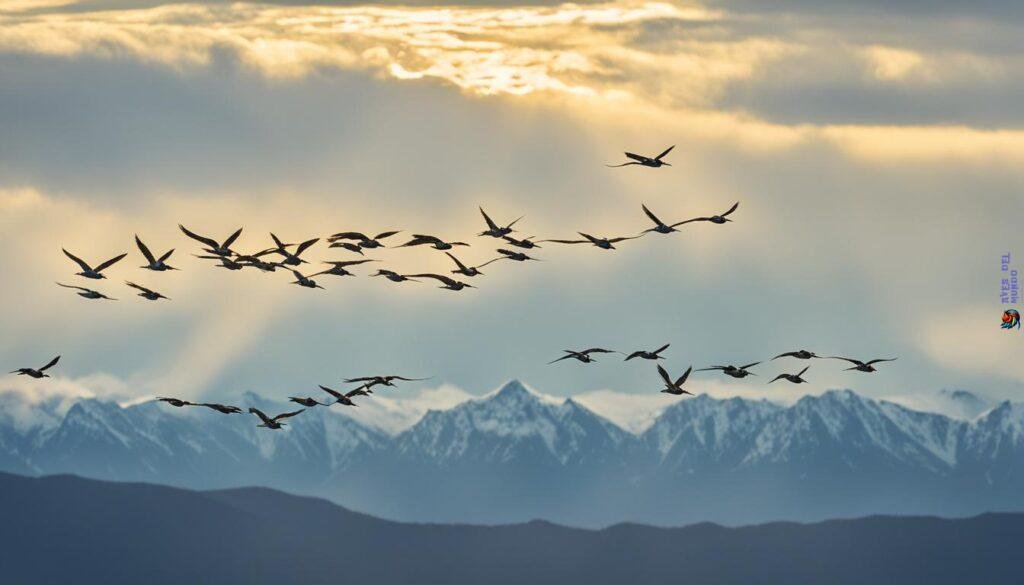
Ever wonder how the Great Snipe can fly so far? It’s about how the bird manages and saves energy. Its body is made to store energy and use it well during long flights. Here’s a look at what makes the Great Snipe’s energy so impressive:
| Energy Component | Description |
|---|---|
| High-Fat Diet | A diet high in fats gives them lots of energy, perfect for long flights. |
| Efficient Metabolism | Its metabolism turns fat into energy slowly, helping it keep going during its trip. |
| Optimized Flight Mechanics | Its body and wings are shaped to use less energy, letting it fly fast up to 97 km/h. |
| Muscle Composition | Strong flight muscles, especially around the chest, let it fly hard without getting tired. |
When bird watching, think about what migratory birds like the Great Snipe go through. Their amazing abilities make us admire them more. It also shows how important it is to protect where they live and their flying paths. Learning about bird species migration and migratory bird behavior helps us appreciate these birds and nature more.
Watching the Great Snipe migrate is special, whether you’re experienced or new to birding. It shows the strength and cleverness of life in the sky. Let’s ensure they’re around for others to see and enjoy in the future.
Cultural versus Genetic Inheritance: How Birds Learn to Migrate
The mystery of migratory bird behavior combines culture and genetics. Bird lovers and scientists study bird migration patterns to find out interesting facts. They see how many bird species migration knowledge passes down through families. This knowledge helps birds travel long distances safely.
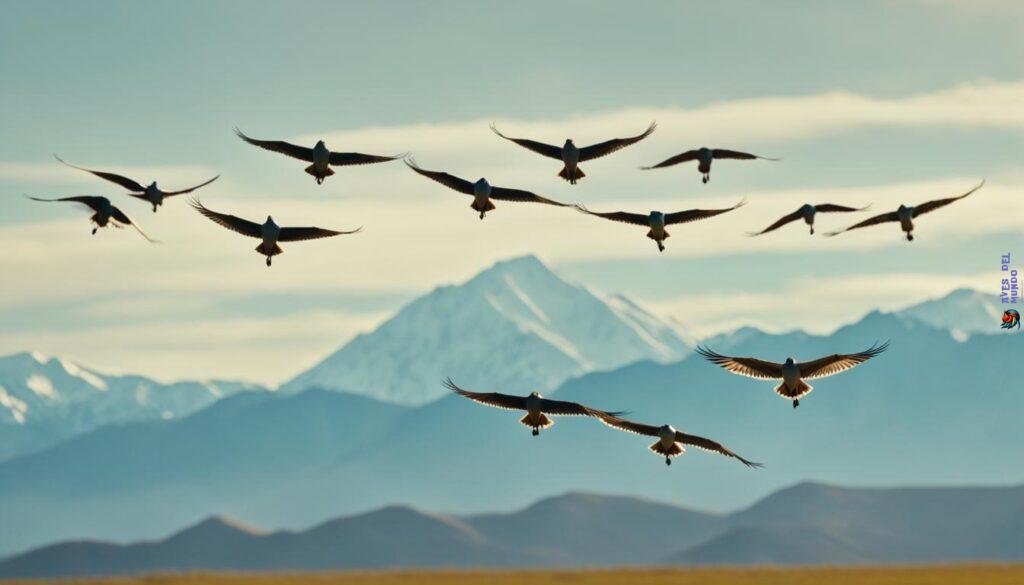
The Role of Parental Guidance in Migration
Parents play a huge role in teaching birds to migrate. For example, the male Caspian tern shows its chicks how to migrate. This parent-to-child teaching is key for some birds’ survival. It helps them know their way, recognize landmarks, and make stops.
Innate Behaviors and Natural Navigational Skills
But, migration isn’t just learned; some birds are born with a natural sense of direction. They have built-in skills for navigation, like cuckoos that migrate alone the first time. They use the earth’s magnetic fields, stars, and sun to guide them. This helps them cross lands and oceans without help.
Now, you know more about migratory bird behavior. This includes both learned and genetic ways birds navigate during migration. The way these creatures migrate remains fascinating and inspiring to many of us.
Maximizing Bird Watching During Migration Seasons
When birds migrate, it’s the best time to watch them. They show us their strength and beauty. As watchers, we learn a lot by seeing bird migration. It’s amazing to see birds like the Arctic Tern travel so far. Watching them fly over us, we see up close how amazing these birds are.
Knowing when birds migrate is key. Plan your bird watching to see them travel like champions. Being part of a group that protects birds is important. Helping by planting native plants gives birds food and a place to rest. Taking steps like this helps their long trip.
Bird watching is not just for fun. It helps us learn about birds and how to protect them. As watchers, we do more than just look. We help them live better lives. So, let’s enjoy watching them fly by, making their incredible journey.
